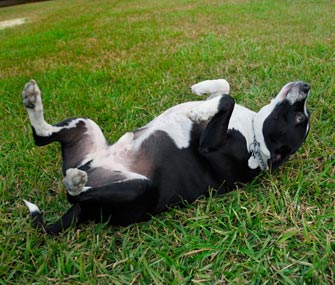Why Does My Dog… Roll Onto Her Back When She’s Scared?
by Denise Maher
Published on October 10, 2012
Skip To

According to board-certified veterinary behaviorist Dr. Karen Sueda, DVM, of the VCA West Los Angeles Animal Hospital, this is a classic — and normal — sign of submission or appeasement.
A Little Belly-Exposing History
When a dog presents her belly and neck in this situation, she’s expressing an ancestral trait rooted in wolf pack behavior that was used to communicate deference to other “alpha” dogs.On a more practical note, it also helped wolves to avoid getting into a fight. Over time, nature selected appeasing wolves who were able to get out of potentially dangerous situations by peacefully persuading an aggressor to back off.
“The trait has been maintained through evolution, as well as domestication,” Dr. Sueda explains, adding that the habit isn’t necessarily a sign of weakness. It’s quite the opposite, in fact, and shows that she’s a good communicator capable of conveying via body language that there’s no need for a tussle.
When the Behavior May Point to a Problem
If your dog cowers all of the time, she may have a serious phobia.It’s normal for a dog to roll over once in a while, but if it happens consistently in certain situations — like when you pull out the dreaded vacuum cleaner — consider consulting a trainer or a board-certified behaviorist about steps that you can take to ease her anxiety and teach her to make positive associations with the activity or object that’s triggering the fear.
The most important thing, Dr. Sueda says, is to avoid doing anything that can make the fear worse. If your dog’s anxiety is set off by something that you have done, simply walk away, and avoid touching her.
When she rolls over, her body language says, “I don’t want you to come any closer.” If you don’t give her space, you may only escalate her fearful feelings, causing her to potentially get aggressive.





